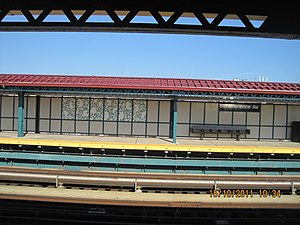New York City Subway station in The Bronx, New York
| St. Lawrence Avenue | ||||||||||||||||||||||||||||||||||||||||||||||||||||||||||||||||||||
|---|---|---|---|---|---|---|---|---|---|---|---|---|---|---|---|---|---|---|---|---|---|---|---|---|---|---|---|---|---|---|---|---|---|---|---|---|---|---|---|---|---|---|---|---|---|---|---|---|---|---|---|---|---|---|---|---|---|---|---|---|---|---|---|---|---|---|---|---|
 | ||||||||||||||||||||||||||||||||||||||||||||||||||||||||||||||||||||
| Station statistics | ||||||||||||||||||||||||||||||||||||||||||||||||||||||||||||||||||||
| Address | St. Lawrence Avenue & Westchester Avenue Bronx, New York | |||||||||||||||||||||||||||||||||||||||||||||||||||||||||||||||||||
| Borough | The Bronx | |||||||||||||||||||||||||||||||||||||||||||||||||||||||||||||||||||
| Locale | Soundview | |||||||||||||||||||||||||||||||||||||||||||||||||||||||||||||||||||
| Coordinates | 40°49′54″N 73°52′02″W / 40.831573°N 73.867307°W / 40.831573; -73.867307 | |||||||||||||||||||||||||||||||||||||||||||||||||||||||||||||||||||
| Division | A (IRT) | |||||||||||||||||||||||||||||||||||||||||||||||||||||||||||||||||||
| Line | IRT Pelham Line | |||||||||||||||||||||||||||||||||||||||||||||||||||||||||||||||||||
| Services | 6 (all times) | |||||||||||||||||||||||||||||||||||||||||||||||||||||||||||||||||||
| Transit | ||||||||||||||||||||||||||||||||||||||||||||||||||||||||||||||||||||
| Structure | Elevated | |||||||||||||||||||||||||||||||||||||||||||||||||||||||||||||||||||
| Platforms | 2 side platforms | |||||||||||||||||||||||||||||||||||||||||||||||||||||||||||||||||||
| Tracks | 3 | |||||||||||||||||||||||||||||||||||||||||||||||||||||||||||||||||||
| Other information | ||||||||||||||||||||||||||||||||||||||||||||||||||||||||||||||||||||
| Opened | May 30, 1920; 104 years ago (1920-05-30) | |||||||||||||||||||||||||||||||||||||||||||||||||||||||||||||||||||
| Rebuilt | February 28, 2011; 13 years ago (February 28, 2011) to October 16, 2011; 13 years ago (October 16, 2011) | |||||||||||||||||||||||||||||||||||||||||||||||||||||||||||||||||||
| Opposite- direction transfer | Yes | |||||||||||||||||||||||||||||||||||||||||||||||||||||||||||||||||||
| Traffic | ||||||||||||||||||||||||||||||||||||||||||||||||||||||||||||||||||||
| 2023 | 816,020 | |||||||||||||||||||||||||||||||||||||||||||||||||||||||||||||||||||
| Rank | 330 out of 423 | |||||||||||||||||||||||||||||||||||||||||||||||||||||||||||||||||||
| ||||||||||||||||||||||||||||||||||||||||||||||||||||||||||||||||||||
| ||||||||||||||||||||||||||||||||||||||||||||||||||||||||||||||||||||
| ||||||||||||||||||||||||||||||||||||||||||||||||||||||||||||||||||||
| ||||||||||||||||||||||||||||||||||||||||||||||||||||||||||||||||||||
| ||||||||||||||||||||||||||||||||||||||||||||||||||||||||||||||||||||
The St. Lawrence Avenue station is a local station on the IRT Pelham Line of the New York City Subway. The station, served by the 6 train at all times, is located at the intersection of St. Lawrence Avenue and Westchester Avenue in the Soundview neighborhood of the Bronx.
History
St. Lawrence Avenue station opened on May 30, 1920 as the Pelham Line was extended to East 177th Street from Hunts Point Avenue. The construction of the Pelham Line was part of the Dual Contracts, signed on March 19, 1913 and also known as the Dual Subway System. The Pelham Line was built as a branch of the Lexington Avenue Line running northeast via 138th Street, Southern Boulevard and Westchester Avenue. Initially, the extension was served by a shuttle service operating with elevated cars. Passengers transferred to the shuttle at Hunts Point Avenue.
Station layout
| Platform level | Side platform | |
| Southbound local | ← | |
| Peak-direction express | ← | |
| Northbound local | → | |
| Side platform | ||
| Mezzanine | Fare control, station agent, MetroCard and OMNY machines | |
| Ground | Street level | Exit/entrance |

The station has three tracks and two side platforms. The center express track is used by the <6> service during weekdays in the peak direction. The 6 local train serves the station at all times. The next stop to the south is Morrison Avenue–Soundview, while the next stop to the north is Parkchester.
The station resembles other elevated stations along the line: it has a wood mezzanine and no windscreens along the platform edges. St. Lawrence Avenue is the northernmost station on the IRT Pelham Line that does not serve rush-hour express service.
Exits
There is a mezzanine below the east end of the station, which contains the station's only exit. Outside fare control, exit stairs lead to the southwest and northeast corners of Westchester Avenue and St. Lawrence Avenue.
References
- "Glossary". Second Avenue Subway Supplemental Draft Environmental Impact Statement (SDEIS) (PDF). Vol. 1. Metropolitan Transportation Authority. March 4, 2003. pp. 1–2. Archived from the original (PDF) on February 26, 2021. Retrieved January 1, 2021.
- ^ "Bronx Subway Extension Opened" (PDF). New York Times. May 28, 1920. Retrieved January 25, 2016.
- ^ "Annual Subway Ridership (2018–2023)". Metropolitan Transportation Authority. 2023. Retrieved April 20, 2024.
- Brooklyn Daily Eagle Almanac. Brooklyn Daily Eagle. 1922. p. 372.
- Annual Report for the Year Ending June 30, 1920. Interborough Rapid Transit Company. 1920. pp. 5, 13.
- nycsubway.org—The Dual Contracts
- "The Dual System of Rapid Transit (1912)". www.nycsubway.org. Retrieved March 25, 2014.
- Cunningham, Joseph; DeHart, Leonard O. (1993). A History of the New York City Subway System. J. Schmidt, R. Giglio, and K. Lang. p. 48.
- Dougherty, Peter (2006) . Tracks of the New York City Subway 2006 (3rd ed.). Dougherty. OCLC 49777633 – via Google Books.
- "6 Subway Timetable, Effective December 15, 2024". Metropolitan Transportation Authority. Retrieved December 16, 2024.
- "Subway Map" (PDF). Metropolitan Transportation Authority. September 2021. Retrieved September 17, 2021.
- "MTA Neighborhood Maps: Bronx Zoo" (PDF). mta.info. Metropolitan Transportation Authority. 2015. Retrieved July 20, 2016.
External links
- nycsubway.org – IRT Pelham Line: St. Lawrence Avenue
- Station Reporter — 6 Train
- The Subway Nut — St. Lawrence Avenue Pictures Archived March 25, 2010, at the Wayback Machine
- St. Lawrence Avenue entrance from Google Maps Street View
- Platforms from Google Maps Street View (Daytime)
- Platforms from Google Maps Street View (Night)
| Stations of the New York City Subway, by line (physical trackage) | |
|---|---|
| Pelham Line |
|
| |


